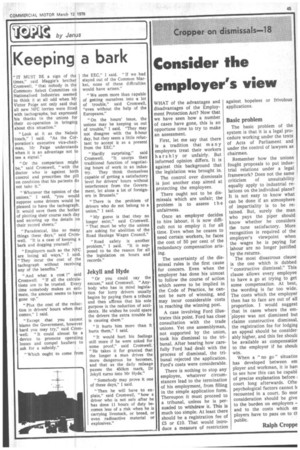Consider the employer's view
Page 67

If you've noticed an error in this article please click here to report it so we can fix it.
WHAT of the advantages and disadvantages of the Employment Protection Act? Now that we have seen how a number of cases have gone, this is an opportune time to try to make an assessment.
First, let me say that there is a tradition that many employers treat their workers harshly or unfairly. But informed opinion differs. It is against this background that the legislation was brought in.
The control over dismissals is just another step aimed at protecting the employees.
There ought not to be dismissals which are unfair; the problem is to assess t he unfairness.
Once an employer decides to hire labour, it is now difficult not to employ it for all time. Even when he ceases to need certain workers, he faces the cost of 50 per cent of the redundancy compensation arising, The uncertainty of the dismissal rules is the first cause for concern. Even when the employer has done his utmost to follow the course of action which seems to be implied in the Code of Practice, he cannot be sure of winning, and may incur considerable costs in reaching the winning post.
A case involving Ford illustrates this point. Ford has close consultation with the trade unions. Yet one assemblyman, not supported by the union, took his dismissal to the tribunal. After hearing how carefully Ford had dealt with the process of dismissal, the tribunal rejected the application. Ford's costs were considerable.
There is nothing to stop any employee, whatever circumstances lead to the termination of his employment, from filling in the simple application form. Thereupon it must proceed to a tribunal, unless he is persuaded to withdraw it. This is much too simple. At least there should be a registration fee of £5 or £10. That would introduce a measure of restriction against hopeless or frivolous applications.
Basic problem
The basic problem of the system is that it is a legal procedure working under the texts of Acts of Parliament and under the control of lawyers as chairmen.
Remember how the unions fought proposals to put industrial relations under a legal framework? Does not the same criticism of unsuitability equally apply to industrial relations on the individual plane? It is not easy to know what can be done if an atmosphere of impartiality is to be retained. But, surely the man who pays the piper should know whether he considers the tune satisfactory. More recognition is required of the employer's viewpoint when the wages he is paying for labour are no longer justified by the returns.
The most disastrous clause is the one which is dubbed "constructive dismissal." This clause allows every employee to have a go at trying to get some compensation. At best, the wording is far too wide. The costs which the employer then has to face are out of all proportion. I would suggest that in cases where the em'ployee was not dismissed but claims constructive dismissal, the registration fee for lodging an appeal should be considerably higher, and this fee shoulc be available as compensatior to the employer if he shouk win.
When a "no go" situatior has developed between em ployer and workman, it is hal% to see how this can be capabi.
of precise explanation before ; court long afterwards. Ofte.
psychological factors cannot b recounted in a court. So mor consideration should be give to the burden on employers and to the costs which en ployers have to pass on to th public.
















































































































